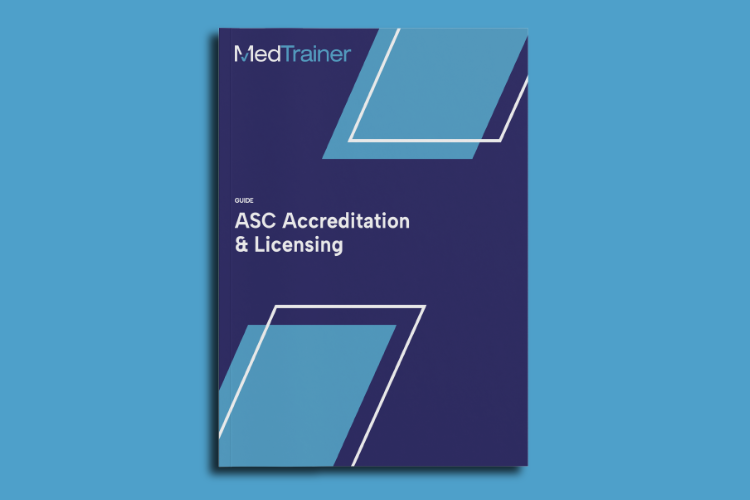When most people think about healthcare settings, they usually imagine the effort that goes into treating sick or injured patients. Patient care might be the ultimate focus and core goal for the industry, but there’s much more going on behind the scenes — including accreditation.
Accreditation is key to demonstrating that your healthcare organization meets certain industry or organizational standards. While you might already be familiar with accreditation, it’s essential to know exactly what accreditation entails and how to maintain compliance in a healthcare setting. Here’s a general overview of accreditation, and how using accreditation management software can help your organization.

Get our best tips to navigate the accreditation process.
What Is Accreditation?
Accreditation is the method by which organizations such as hospitals, practices, and other healthcare-related institutions establish their ability to meet the requirements and standards of regulatory agencies that govern different aspects of the healthcare industry.
Accreditation standards vary between organizations. While each accrediting body has their own procedure and timeline, there are a few common steps in each process:
- Unannounced visit (usually two to three days)
- Staff member interviews
- Facility tours (including operating rooms)
- Review of credentialing files and patient medical records
- Review of inspection, fire drill, refrigeration temperature, quality improvement studies, infection control and other performance-related documentation
- Inspection of medication security, expiration dates, and other supplies
Facilities which use online compliance platforms often have an easier, faster time achieving accreditation. It’s easier for surveyors to find the appropriate information and verify that it complies with standards.
Once the surveyor examines the facility and confirms that it meets with the body’s standards, the facility is awarded accreditation. This demonstrates to patients, physicians, and staff that the organization excels in both its administrative and patient duties. This ensures patient and industry trust.
Accreditation vs. Licensure vs. Certification
While the average layperson might think that accreditation, licensure, and certification are all different terms for the same concept, they’re actually quite different.
- Accreditation demonstrates that a facility has met another organization’s standards for efficiency, ethics, safety, and professionalism.
- Licensure, on the other hand, is granted to individuals so that they may practice their occupation. Healthcare licensure is usually granted by the government on a statewide basis, just like how lawyers have to pass the state Bar exam to practice law in each state.
- Finally, certification is a third-party evaluation of an individual by a non-governmental body.
What Are the Benefits of Accreditation?
According to a study performed by the National Institutes of Health, accreditation programs significantly improved the processes involved in patient care.
Accreditation initiatives — normally done on a voluntary basis — reinforce core objectives to maintain compliance with quality standards to better patient care and internal administration. The study looked at bibliographic databases spanning several decades and examined key markers to evaluate specialties and the impact of accreditation on healthcare services. Decisive improvements were noted when healthcare organizations set goals for different accreditations.
When you achieve accreditation, it acts as a “seal of approval” for your organization. Accredited organizations have demonstrated high standards of care and compliance — developing trust with the public and a positive reputation that results in increased patient retention and revenue. Benefits of accreditation include:
- Improved patient care with consistent, quality processes
- Showing potential staff that you’re serious about patient care
- Better risk management and risk reduction
- Increased referrals from providers
- Strengthens community confidence in the quality and safety of care
- Improves payer relations with a commitment to compliance
- Provides deeming authority for Medicare certification
- Provides recognition by insurers and other third parties
- Provides a framework for organizational structure and management
Because accreditation fees and processes vary, you’ll have to make a cost/benefit analysis for each type of accreditation you pursue. The guide to ASC accreditation includes which questions to ask when you’re determining whether a specific accreditation is worth the investment.
How Does Accreditation Management Software Help?
Accreditation is important for your healthcare organization’s public image and to establish patient/provider trust. However, meeting accreditation standards is by no means easy. With so many responsibilities, it can be incredibly challenging to stay on top of everything while also running the day-to-day operations at the facility.
Accreditation management software exists to help ease the burden of document storage and other problems associated with accreditation. By using specialized software to manage your accreditation process, you won’t have to worry about the hassle of paperwork.
| Potential Accreditation Pitfall | How Technology Can Help |
| Unable to locate documents quickly | Store all documents and policies in one unified software platform that any employee can access from anywhere.
|
| Incomplete HR/credentialing files | Store all Primary Source Verification documents, provider information, and communications in an online provider profile with automated notifications when documents are expiring or missing.
|
| Incomplete or missing logs | Maintaining OSHA logs and incident reports in an online platform makes it easier for employees to complete documentation as soon as an incident happens. It is also easier to identify trends and escalate issues.
|
| Observed practices not aligned with policy | Record training on your organization’s policies and procedures and upload it to your learning management system. There, you can add in knowledge checks and track completion.
|
| Non-compliance with initial or ongoing education | Using an online learning management system ensures your training is always up-to-date and makes it easy to identify employees who have not yet completed it. Real-time reports and automated reminders help to ensure it is completed.
|
For further guidance, watch this webinar featuring two accreditation surveyors who share their insights from hundreds of onsite visits.
When you use cloud-based systems, your accreditation documentation is easily accessible and searchable, which can streamline the overall process. Some systems provide basic accreditation guidance, while others may focus on specific accrediting bodies like the AAASC. Ultimately, however, accreditation software saves your facility time and helps you stay compliant with industry standards.
MedTrainer Helps Facilities Meet Accreditation Requirements
If you need accreditation compliance software, MedTrainer is the ideal solution. MedTrainer offers comprehensive accreditation programs that cover a range of healthcare compliance initiatives. With our easy-to-use software, you’ll benefit in more ways than one.
By utilizing MedTrainer for accreditation needs, your healthcare organization can streamline internal administrative processes and improve patient outcomes to create an ideal environment for staff and clients alike. With the help of accreditation management software, a once tedious process is much easier. Here’s how MedTrainer can help:
Learning Courses Designed To Meet Accreditation Standards
MedTrainer’s course catalog includes nearly 1,000 healthcare-specific trainings with many designed to meet the standards of the most common accrediting bodies, including:
- Accreditation Association for Ambulatory Health Care (AAAHC)
- American Association for the Accreditation of Ambulatory Surgery Facilities (Quad A)
- Accreditation Commission for Health care (ACHC)
- Commission on Accreditation for Rehabilitation Facilities (CARF)
- The Joint Commission (TJC)
Organize Documents and Policies in MedTrainer Compliance
MedTrainer’s compliance software also helps create consistency in your document and policy management:
- Streamline manual document and policy management processes
- Lower risk of mistakes and delays
- Increase efficiency with centralized document and policy management and storage
- Improve your facility’s compliance with customizable scheduled reports that detail document approval and acceptance processes
- Improve staff communications and attestations with digital signature and automated email reminder functionality
Bring All Credentialing Documents Into MedTrainer Credentialing Software
MedTrainer’s cloud-based credentialing software can help you automate the credentialing process and monitor progress in real time. MedTrainer offers visibility and credential tracking to achieve your goals and ensure no revenue falls between the cracks. Your process is always easily accessible, visible, and stored in the cloud. Instead of manually updating your credentialing documents, do it automatically from a single platform.
If you’re interested in learning more about MedTrainer — and how we can help you streamline accreditation — schedule a product demo today.
